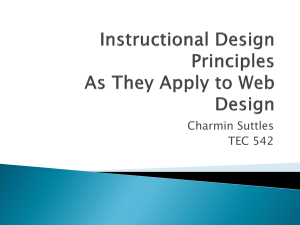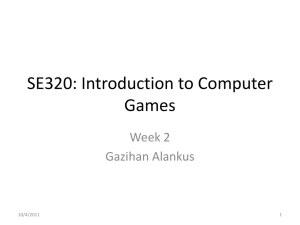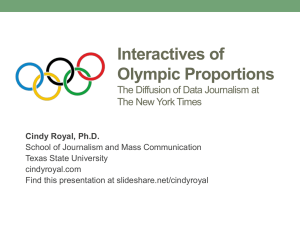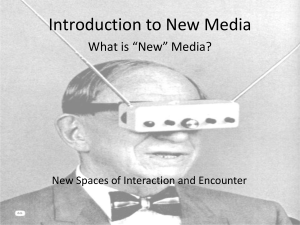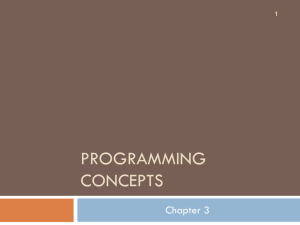Four Models of Cyber-Interactivity: Individual Perceptions of
advertisement
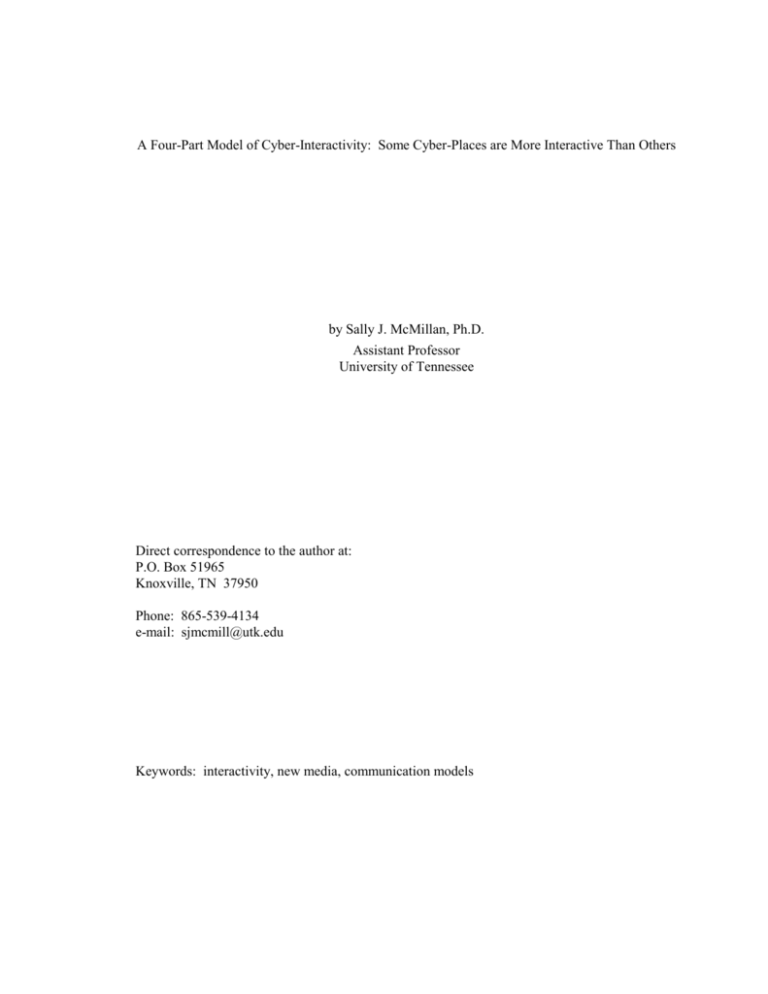
A Four-Part Model of Cyber-Interactivity: Some Cyber-Places are More Interactive Than Others by Sally J. McMillan, Ph.D. Assistant Professor University of Tennessee Direct correspondence to the author at: P.O. Box 51965 Knoxville, TN 37950 Phone: 865-539-4134 e-mail: sjmcmill@utk.edu Keywords: interactivity, new media, communication models Author Biography Sally J. McMillan is an assistant professor at the University of Tennessee. Her research focuses on the individual, organizational and social impacts of interactive communication technologies and has been published in journals such as Journalism and Mass Communication Quarterly, the Journal of Computer-Mediated Communication, and New Media and Society. The author thanks Jennifer Browning, Susanna Lamminpaa, and Khai Nguyen for their research assistance. Address: The University of Tennessee, College of Communication, 476 Communication Building, Knoxville, TN 37996. [e-mail: sjmcmill@utk.edu]. A Four-Part Model of Cyber-Interactivity: Some Cyber-Places are More Interactive Than Others ABSTRACT Existing communication models and definitions of interactivity provide both background and structure for a new model of cyber-interactivity that is introduced and explored in this article. Two primary dimensions, direction of communication and level of receiver control over the communication process, provide the primary framework for this new model of computermediated cyber-interactivity. A study designed to explore the applicability of this model analyzed 108 health-related Web sites using both perception-based and feature-based measures of these two dimensions. No significant correlation was found between the perception-based and feature-based models. The perception-based model was a better predictor of attitude toward the Web site and perceived relevance of the subject of the site than was the feature-based model. However, the feature-based model may hold greater promise as a tool for site developers who seek to incorporate appropriate levels of interactivity in their Web sites. Model of Cyber-interactivity 1 Much of the literature on computer-mediated communication assumes that it is interactive. But more work is needed in defining the concept of interactivity. One frequently cited definition comes from Rafaeli (1988, p. 11), who defined interactivity as: ‘An expression of the extent that, in a given series of communication exchanges, any third (or later) transmission (or message) is related to the degree to which previous exchanges referred to even earlier transmissions.’ Rafaeli has conducted a number of studies (see for example Rafaeli, 1990; Rafaeli & Sudweeks, 1997) in which he examined interactivity as a process-related variable based on relatedness of sequential messages. This article explores the concept of interactivity by going beyond the single dimension suggested by Rafaeli. Several authors have suggested that interactivity may be a multi-dimensional construct (see for example, Durlak, 1987; Ha & James, 1998; Heeter, 1989; Jensen, 1998; Massey & Levy, 1999; McMillan, 1998). But no literature identified to date has presented a model based on two dimensions that define a four-part typology of interactivity. As illustrated in the following review of the literature, such models have been useful in describing and prescribing other communication phenomenon. This article develops such a four-part typology of cyber-interactivity. William Gibson (1984) coined the term ‘cyberspace’ to refer to a data-based environment. The ‘cyber’ prefix has since come to be associated with many different forms of computer-mediated communication and experience. The early work on interactivity by researchers such as Rafaeli and Heeter was conducted prior to the widespread adoption of cyber-technologies such as the Internet and the World Wide Web. Although these particular technologies will probably be eclipsed by future technologies, they do represent a major leap into cyberspace and they have popularized the concept of interactivity. Now it is time for researchers to examine how cyber-interactivity can be understood within the context of existing theory and within new theories that help to explain why some cyber-places seem to be more interactive than others. Model of Cyber-interactivity 2 LITERATURE REVIEW Four different perspectives are useful in examining interactive communication: mass communication, organizational communication, individual communicators, and media features. Additionally, it is important to explore potential effects of interactivity. A Mass Communication Model Many students of communication have been introduced to the Bordewijk and van Kaam (1986) four-part typology of information traffic through McQuail’s (1994) mass communication theory textbook. The key element of the Bordewijk and van Kaam typology is control. One dimension of the model is defined by control of information source and the other by control of time and choice of subject. For both of these variables, the Dutch scholars suggested that control may reside either in a central source or with the individual. The resulting four-part typology is illustrated in Figure 1. FIGURE 1 ABOUT HERE Allocution refers to situations in which information is distributed from a center simultaneously to many peripheral receivers. The pattern applies to many mass media as well as to other communication forms such as lectures or concerts. Allocution is typically one-way communication with very little feedback opportunity. Consultation occurs when an individual looks for information at a central information store. In the context of computer-mediated communication this may include databases, CD-ROM, etc. Registration is, in essence, the reverse of Consultation. The organization at the center receives information from a participant at the periphery. This applies when central records are kept of individuals in a system and it also applies to systems of surveillance. The accumulation of information at a center often takes place without reference to, or knowledge of the individual. Many communication technologies make Registration more feasible. The use of ‘cookies’ to track and customize content for visitors to Web sites is one example of the Registration potential of computer-mediated communication. Model of Cyber-interactivity 3 Conversation occurs when individuals interact directly with each other bypassing central controls or intermediaries. Individuals choose their communication partners as well as the time, place, and topic of communication. Massey and Levy (1999) categorize this conversational-style interactivity as ‘interpersonal interactivity’ to differentiate it from what they categorize as ‘content interactivity;’ the degree to which content creators empower consumers over content. Jensen (1998) used the Bordewijk and van Kaam (1986) typology as the basis for his exploration of interactivity in computer-mediated environments. He defined interactivity as (p. 201): ‘A measure of a media’s potential ability to let the user exert an influence on the content and/or form of the mediated communication.’ In this context, he suggested that interactivity can be sub-divided using the same basic concepts introduced in Figure 1. Transmissional (or Allocutional) interactivity is a measure of a medium’s potential to let the user choose from a continuous stream of information in a one-way media system. Consultational interactivity is a measure of a medium’s potential to let the user choose, by request, from an existing selection of preproduced information in a two-way media system. Registrational interactivity is a measure of a medium’s potential to register information from, and thereby also adapt and/or respond to, a given user’s explicit choice of communication method. Conversational interactivity is a measure of a medium’s potential to let the user produce and input his/her own information in a two-way media system. Fidler (1997) theorized that the new cyber-media are merely one more phase in the evolution of media, or what he calls ‘mediamorphosis.’ He identified three ‘domains’ of communication: Broadcast, Document, and Interpersonal. He suggested that technology enables individuals to experience the Interpersonal domain in new ways. However, he argued that much of the future of computer-mediated communication would continue to draw on the Broadcast and Document domains. He suggested that these forms are likely to resemble Allocution, Consultation, and Registration while Conversation will remain a separate form in the Interpersonal domain. Model of Cyber-interactivity 4 An Organizational Communication Model Both Fidler (1997) and Jensen (1998) emphasized two-way communication in their discussions of evolving computer-mediated, interactive media. A well-known organizational communication model further explores the concept of communication direction. Grunig and Grunig (1989) identified a fourpart model of public relations practice. As illustrated in Figure 2, direction of communication and goals of communication are the two key variables in that model. FIGURE 2 ABOUT HERE Unlike the Bordewijk and van Kaam (1986) typology, which grows out of the mass communication tradition, the Grunig and Grunig (1989) typology grows from the organizational communication tradition. The Grunigs suggested that organizations can be most effective when they establish a dialogue with their publics. They identified social science research as the primary tool for developing this dialogue. However, the advent of tools such as e-mail and the World Wide Web suggest new ways in which organizations may establish two-way communication with their publics. In the Press Agentry type, the organization tries to persuade key publics using techniques typical of Allocution. In the Public Information type, the organization sees the primary purpose of public relations as information dissemination. The individual’s use of this information may often resemble Consultation. As organizations move to adopt more two-way communication, they sometimes seek information from their publics that will allow the organization to persuade more effectively. This TwoWay Asymmetric type, sometimes referred to as scientific persuasion, may often utilize techniques typical of Registration as identified in Figure 1. But, to achieve the Grunigs’ ideal of Two-Way Symmetric communication, organizations often have to develop a more conversational approach to communicating with their publics. The Grunig and Grunig (1989) model has served as the basis for a large body of public relations literature that is both normative and prescriptive. Organizational factors such as regulatory threats, scale of operations, and the position of communicators within the power structure of organizations have been Model of Cyber-interactivity 5 used to identify which models organizations use and/or should use (for an in-depth application of these models, see Grunig & Dozier, 1992). A New Model from the Individual Perspective Morrison (1998) suggested that failure to view evolving media from the user’s perspective may be a blind spot in the study of interactivity. Newhagen (1998) noted that traditional concepts of ‘audience’ become virtually irrelevant in the context of the Internet. Rather, the individual user comes to conceptual center stage. While theoretical perspectives arising from the mass media and organizational communication traditions may provide a useful framework for understanding the basic nature of interactive communication, it is the uses that individuals make of evolving media that may better explain the interactive process. Williams, Stover, and Grant (1994) suggested that although media technologies change rapidly, understanding individuals’ uses of those media is a key step in the theory-building process. Wu (1999) also focused on the need to study interactivity from the perspective of perceptions of those who use interactive media. Johnson (1998) also argued that a user-centered approach is critical for effective design of human-computer interfaces. McMillan and Downes (2000) conducted interviews with individuals who teach, research, and create content in the evolving environment of computer-mediated communication. From those interviews, they identified two primary dimensions that seem to form the basis for perceptions of interactivity: direction of communication and control over the communication process. Direction of communication was central to the Grunig and Grunig (1989) model while control was central to the Bordewijk and van Kaam (1986) model. These two concepts have also been explored in the literature on interactivity. Within the CMC tradition, a fundamental assumption is that two-way communication flows back and forth among communication participants (see for example: Bretz, 1983; Duncan Jr., 1989; Durlak, 1987; Garramone, Harris, & Pizante, 1986; Kirsh, 1997; Pavlik, 1998; Rice, 1984; Rogers, 1995). Scholars have also suggested that receiver control is a key dimension of computer-based Model of Cyber-interactivity 6 information systems (see for example: Chesebro, 1985; d'Ambra & Rice, 1994; Finn, 1998; Guedj, tenHagen, Hopgood, Tucker, & Duce, 1980; Kayany, Wotring, & Forrest, 1996; Trevino, Daft, & Lengel, 1990; Zack, 1993). These two key dimensions can be used to form a four-part model of cyber-interactivity that both builds on and expands the models reviewed earlier. Figure 3 presents such a model. In Figure 3, control is illustrated with circles indicating individuals’ role in communication. Direction of communication is illustrated with arrows or overlapping circles. FIGURE 3 ABOUT HERE Monologue, with primarily one-way communication and relatively little receiver control over the communication process, resembles both Allocution and Press Agentry. Senders create and disseminate content to attract an audience, promote a product or service, build a brand, or perform some other persuasive communication function. Most corporate Web sites provide an example of Monologue. Feedback is still primarily one-way communication but it allows receivers to have limited participation in the communication process. Feedback tools such as e-mail links allow the receiver to communicate with the sender. However, in this model, the sender and receiver roles are still very distinct. Even though the receiver may communicate with the sender, there is no guarantee that the sender will respond to the Feedback that has been received. In some ways, Feedback resembles both Consultation and Public Information. The receiver can consult with the provider of information in terms over which the receiver has some control. In other words, there may be some symmetry in the communication goals. Responsive Dialogue enables two-way communication but the sender retains primary control over communication. This type strongly resembles the Two-Way Asymmetric model. It may also use techniques typical of the Registration model for monitoring the communication process. Responsive Dialogue may take place in environments such as e-commerce in which the sender makes goods and services available, the receiver selects and orders desired goods/services, and the sender acknowledges Model of Cyber-interactivity 7 receipt of the order. Online customer support sites, and sites that solicit volunteer participation in nonprofit organizations, may also utilize Responsive Dialogue. Mutual Discourse enables two-way communication and gives receivers a great deal of control over the communication experience. This strongly resembles the Conversation and Two-Way Symmetric models. The sender and receiver roles become virtually indistinguishable in environments such as chat rooms, bulletin boards, etc. A key to Mutual Discourse is that all participants have the opportunity to send and receive messages. Media Features Each of the above models addresses communication and interactivity from the perspective of key dimensions: control of information source and control of time and choice of subject in the Bordewijk and van Kaam (1986) model, direction and goals of communication in the Grunig and Grunig (1989) model, and direction and control of communication in the new model of cyber-interactivity. Another body of literature addresses the concept of interactivity from the perspective of media features. Researchers in this tradition define interactivity based on how many and what types of features allow for interactive communication. Much of this feature-based research grows out of Heeter’s (1989) conceptual definition of interactivity. She suggested that interactivity resided in the processes, or features, of a communication medium. Massey and Levy (1999) operationalized Heeter’s conceptual definition and examined Web sites for interactivity based on presence of functional features such as e-mail links, feedback forms, and chat rooms. McMillan (1998) also used Heeter’s conceptual definition of interactivity to identify features of Web sites that may be considered interactive. Her feature list also included many of those identified by Massey and Levy as well as bulletin boards, search engines, and forms for registration and online ordering. Ha and James (1998) identified additional interactive features including curiosityarousal devices, games, user choice, and surveys. Model of Cyber-interactivity 8 Generally, the researchers who coded for these features operated under the assumption that the more of these features were found in Web-based communication, the more interactive the communication at that site was likely to be. However, it is also possible to divide these features into those that are used primarily to facilitate two-way communication and those that are designed to enhance the receiver’s control over communication. These two dimensions can be used to conceptualize the model in Figure 3 from a feature-based rather than a perception-based perspective. Rather than considering interactive features as having a cumulative effect on interactivity, the model can help researchers identify different forms of interactivity based on the balance of features that facilitate two-way communication and/or receiver control of communication. The first research question explores the relationship between this feature-based approach to interactivity and the perceptual approach suggested earlier. RQ1 How similar are models of cyber-interactivity defined by perceptions of the two key dimensions of interactivity (direction and control) and those defined by features that facilitate direction and control of communication? Effects of Interactivity For many communication scholars and practitioners, exploring the concept of interactivity from both user- and feature-based perspectives is considered a preliminary step to understanding the effects of interactivity. Researchers have begun to explore relationships between interactivity and factors such as attitude toward the Web site (McMillan, 2000a; Oginanova, 1998; Wu, 1999). Additionally, exploratory research (McMillan, 2000a) has suggested that there may be some relationship between interactivity and the perceived relevance of the topic of a Web site. And, among communication scholars and practitioners, there is a widespread hope that increased interactivity will lead to increased likelihood of behaviors such as returning to a Web site, referring others to the site, and purchasing from a site (Bezjian-Avery, Calder, & Iacobucci, 1998; Cooley, 1999; Rodgers & Thorson, 2000; Singh & Dalal, 1999; Sundar, Narayan, Obregon, & Uppal, 1998). Model of Cyber-interactivity 9 However, while the literature has begun to explore the effects of interactivity, much of that literature has failed to distinguish between perception-based and feature-based models of interactivity when examining potential effects. The second research question explores potential effects of interactivity based both on perceived interactivity and interactive features of Web sites. RQ2 What relationships exist between both perception-based and feature-based models of cyberinteractivity and: a) attitude toward the Web site b) relevance of site topic c) behavioral intentions? METHOD This article reports an exploratory study that is designed to evaluate the model of cyber- interactivity introduced in Figure 3 and address the two primary research questions posed above. Examination of 108 health-related Web sites was central to this study. These sites provide an interesting venue for analysis of Web sites for three reasons. First, health-related topics have played a central role in media development (See for example; Barnouw, 1966; Jones, 1996). Second, health-related sites have long been one of the fastest growth areas on the Web (Fisher, 1996). Third, health-related sites are used heavily (Pingree et al., 1996). These sites were part of a larger sample of sites randomly selected from the Yahoo directory of health-related Web sites in January 1997 (McMillan, 1998). The sites analyzed in the current study were still operating three years later in January 2000. Thus, an additional strength of using these particular sites is that they have survived a turbulent growth period in the history of the Web (McMillan, 2000b). All of the sites were downloaded and saved for analysis in January 2000. Two forms of analysis were used to examine the research questions. First, 31 undergraduates were assigned to review approximately 10 of the selected sites. These students are referred to as untrained codes because they were given no instructions other than to “surf” the site for about 10 minutes. Following that review they were asked to rate the sites based on their perceptions of the two key dimensions of interactivity identified in Figure 3. The wording of those two items appears in Table Model of Cyber-interactivity 10 1. Both items were coded on a seven-point scale for which 1 = strongly disagree and 7 = strongly agree. Overall average scores for both dimensions are also shown in Table 1. TABLE 1 ABOUT HERE Three separate untrained coders rated each Web site on these two dimensions of interactivity. Ideally, an average of these three ratings could be used to develop scales for direction and control of communication. However, analysis of the three ratings revealed very low reliability scores (alpha of .22 for direction and .27 for control). Thus, creating a mean from these three separate ratings could confuse findings by creating means that hide differences in rating of sites. The differences in ratings among these untrained coders tends to suggest that perceptions of direction and control of communication may be highly personalized and may be influenced by other factors such as overall attitude toward the site and perceived relevance of the site. Given the exploratory nature of this study, the decision was made to examine only one of these untrained coder’s ratings of interactivity for each site. This single coder’s rating can then be compared with the same coder’s attitude toward the Web site and perceptions of the relevance of the site. The selection of one of the three coders was made arbitrarily. These same 31 untrained coders were also asked to complete scales measuring their attitude toward the Web site, the relevance of the site topic, and their behavioral intentions related to the site. These scales grew out of earlier research that has adapted standard advertising measures of attitude, relevance, and behavior to the Web (see for example McMillan, 2000a; Oginanova, 1998). The items used in these scales are reported in Tables 2, 3, and 4. These tables also show overall averages of student ratings using these scales. TABLES 2, 3, AND 4 ABOUT HERE The second primary form of analysis was identification of interactive features of Web sites. Four trained coders used the downloaded sites to search for and code the presence of site features. Coding time depended on the complexity of the site, but the trained coders reported spending an average of 20-30 minutes reviewing each site. Model of Cyber-interactivity 11 The primary task of this second analysis was identifying and coding site features that had been defined as interactive in the literature (Ha & James, 1998; Massey & Levy, 1999; McMillan, 1998). These features are identified in Table 5. Table 5 also shows which of the features were identified by the coders as facilitating two-way communication and which were identified as facilitating receiver control of communication. Using Holti’s (1969) formula, intercoder reliability of 96.1 percent was achieved for these measures. Discrepancies were due to omissions or oversights and were easily resolved. TABLE 5 ABOUT HERE FINDINGS A brief review of descriptive findings will provide context for review of the research questions. First, both dimensions of perceived interactivity had means slightly above the mid-point on a seven-point scale (see Table 1). This might suggest that this sample of health-related Web sites is relatively interactive. However, by contrast, Table 5 shows that some interactive features were found at relatively few sites (e.g. chat rooms at only about 10 percent of sites). Furthermore, the average number of twoway communication features at these sites was only 1.5 (of a possible 6); the average number of receivercontrol features at these sites was only 2.0 (of a possible 6). Thus, it would seem that the untrained coders rated these sites fairly high on key interactivity dimensions even though the sites have relatively few interactive features. Some other factors seem to be impacting perceived interactivity. Attitude toward the Web site might be such a factor. As illustrated in Table 2, overall attitude toward these sites is also above the mid-point on the seven-point scale. However, despite these high ratings, it should be noted, that scores on measures of behavioral intention are very low (see Table 4). In fact, only the intention to tell someone about the site scored above two on a seven-point scale thus moving it from the ‘very unlikely’ category to being simply ‘unlikely.’ These low scores on behavioral items might be related to the relatively low scores on measures of relevance. As shown in Table 3, the average score for relevance is slightly below the mid- Model of Cyber-interactivity 12 point of this seven-item scale. Perhaps, if subject matter of the sites were of greater relevance to those who were rating the site, more individuals might indicate an intention to take action related to the site. Research question 1 asked: How similar are models of cyber-interactivity defined by perceptions of the two key dimensions of interactivity (direction and control) and those defined by features that facilitate direction and control of communication? To examine this question, the four-part model of cyber-interactivity (see Figure 3) was developed in two ways. First, the model was formed based on the two perception-based dimensions identified in Table 1. Scores less than the mean for direction of communication were coded as one-way communication while scores equal to or greater than the mean were coded as two-way. Scores less than the mean for control were coded as low receiver control while scores equal to or greater than the mean were coded as high control. Web sites were coded as one of the four types of cyber-interactivity identified in Figure 3 based on the combination of those scores. Table 6 reports distribution of the studied sites among the four perception-based types. TABLE 6 ABOUT HERE The second method for forming the model of cyber-interactivity was based on interactive features of the site. Two new variables were calculated for each site. The first totaled all two-way communication features and the second totaled all receiver-control features (see Table 5 for details on features). Scores less than the mean for these two variables were coded as low two-way communication and receiver control while those at or above the mean were scored as high on those two dimensions. Web sites were coded as one of the four types of cyber-interactivity based on scores on these two dimensions. Table 7 reports distribution of the studied sites among the four feature-based types. TABLE 7 ABOUT HERE One might expect a cross tabulation of the perception-based and feature-based models of cyberinteractivity to reveal a strong relationship between perceptions and features. However, as illustrated in Table 8, no significant relationship was found between perception-based and feature-based models. The Model of Cyber-interactivity 13 earlier discussion of discrepancies between the descriptive date found in Tables 1 and 5 may help to explain why no relationships were found between perception-based and feature-based models. TABLE 8 ABOUT HERE The second research question asked: What relationships exist between both perception-based and feature-based models of cyber-interactivity and: a) attitude toward the Web site, b) relevance of site topic, and c) behavioral intentions? Table 9 addresses this question. TABLE 9 ABOUT HERE No significant relationships were found between the feature-based model and attitude, relevance, or behavioral intentions. Nor was there any significant relationship between the perception-based model and behavioral intensions. However, significant relationships were found between the perception-based model and both attitude and relevance. Attitude toward the Web site was most positive for Mutual Discourse sites and least positive for Monologue. Thus, Mutual Discourse sites were not only perceived to be the most ‘interactive’ but also the most positively evaluated sites. This finding is consistent with the theory underlying the model presented in Figure 3. The pattern of ratings for relevance was somewhat unexpected. The sites rated as most relevant were Feedback sites while Responsive Dialogue sites were least relevant. This might reflect the orientation of the coders. As young, healthy, students they may have noted Feedback features in the sites, but had little interest in initiating Responsive Dialogue with creators of sites that focused on topics such as illness and disease. DISCUSSION Earlier definitions of interactivity and models of communication provide insights into the emerging concept of cyber-interactivity, but the proposed model further explains the nature of cyberinteractivity in the context of computer-mediated communication. This study has proposed a four-part Model of Cyber-interactivity 14 model that holds promise for exploring cyber-interactivity both from the perspective of the perceptions of those who use it as a tool for communication and from the perspective of site features. The four-part model of cyber-interactivity has promise as a heuristic device to help site developers think about what they most want to provide in a site. In some cases, the Monologue type with its relatively low scores on both direction and control of communication dimensions might be the most appropriate way to communicate persuasive information. In other cases, developers may want to increase Feedback opportunities by increasing the participants’ level of control over the communication process. If site developers want to develop Responsive Dialogue with visitors, more mechanisms for twoway communication need to be added to the site and site creators must actively respond to messages from site visitors. Finally, Mutual Discourse may often represent both the greatest technological challenge and the greatest potential threat for Web site developers. In these unfettered environments that allow a freeflow of two-way communication, all visitors to the site have the potential to participate in the site as both senders and receivers. This may be appropriate in some cases, but some organizations may wish to consider carefully if they are willing to invest in a level of interactivity that gives everyone everywhere the opportunity to contribute in a way that may either praise or condemn. The model of cyber-interactivity also holds promise for theory development. It brings together concepts found in earlier models of mass communication and organizational communication and it also integrates literature related to both perceived and functional interactivity. Earlier development work on these models (McMillan, 1999) revealed that sites mix elements of multiple models. Further theoretical development could be done to explore how and why such mixing of models occurs. Future research might also examine why Web site developers choose to develop sites with varying levels of interactivity. Future studies may also consider the possibility of teasing out other levels or types of interactivity. The model proposed in Figure 3 focuses on interactivity from the user-to-user perspective. This type of interactivity is consistent with the literature on computer-mediated communication in which Model of Cyber-interactivity 15 the computer serves as a tool that enables interaction between individuals. However, other research traditions may suggest other forms of interactivity. For example, the human-computer interface literature addresses interaction between the individual and the computer (See for example: Aldersey-Williams, 1996; Johnson, 1998; Kay, 1990; Kirsh, 1997; Laurel, 1990; Lieb, 1998; Salzman & Rosenthal, 1994; Simms, 1997). In this type of interactivity, key dimensions might be the nature of the interface (either apparent or transparent to the user) and the center of control (either in the computer or the individual). Other research traditions focus on interactivity between the user and the text or what Szuprowicz (1995) has called user-to-documents interactivity (See for example: Barak & Fisher, 1997; Bezjian-Avery et al., 1998; Blattberg & Deighton, 1991; Borden & Harvey, 1998; Chesebro & Bonsall, 1989; Fredin, 1997; Hunt, 2000; Iser, 1989; Landow, 1992; Mayburry, 2000; Murray, 1995, 1997; Rafaeli & LaRose, 1993; Steuer, 1992; Straubhaar & LaRose, 1996; Williams, Rice, & Rogers, 1988; Xie, 2000). In this type of interactivity, key dimensions might be the nature of the audience (either passive or active) and the level of control that audience members have over the content of the message. Future studies should also address some of the perplexing findings of this exploratory study. For example, when three individuals reviewed the site with the same instructions, why were their ratings for the two key dimensions of interactivity so dissimilar? Would a larger pool of evaluators lead to a more reliable scale? Do coders need to be trained before they can evaluate direction and control of communication at Web sites? Why are the scores on dimensions of perceived interactivity higher than would be expected based on the interactive features at the sites? Are additional scale items needed for developing better measures of perceived direction and control of communication? Why is there so little relationship between the perception-based and feature-based models of interactivity? Would changes in rating and scaling bring the perception-based and feature-based models closer together? Would differentiation between user-to-user, human-to-computer, and user-to-documents interactivity help to resolve differences in perception-based and feature-based interactivity? Model of Cyber-interactivity 16 Qualitative research may be needed to examine why some sites receive similar scores on the perception-based and feature-based dimensions of interactivity while most sites do not. Future studies should also examine other types of Web sites. A better match between content of the sites and orientations of coders might lead to higher scores on measures of relevance as well as behavioral intentions. With more variance in these measures, more relationships might be found between models of cyber-interactivity and both site relevance and behavior related to the site. It is not startling to find significant relationships between the perception-based model and measures of attitude and relevance. Attitude and relevance are also perceptually based and are rated by the same coders who rated perceived direction and control of communication at the sites. However, the complete lack of significant relationships between the feature-based model and measures of attitude, relevance, and action is somewhat unexpected. One might expect sites having more features facilitating two-way communication and receiver control to be perceived more positively. But no support for such a relationship was found in this study. Relevance may be an independent factor that would not relate to the structure of the site. However, one might expect that sites with the potential for greater two-way communication (Responsive Dialogue and Mutual Discourse) would facilitate more behaviors and thus lead to more behavioral intentions. In fact, the numbers in Table 9 do follow this general pattern, but overall behavioral intentions are so few that no significance can be attributed to that pattern. This study suggests that perception-based models are most appropriate for scholars who seek to find relationships between interactivity and other perceptually based factors such as attitude toward a Web site and relevance of the topic of a site. However, this does not mean that the feature-based model should be abandoned. Researchers whose primary interest is in the structure and function of Web sites may find the feature-based model provides valuable insights that not only help to define the site but also help predict which type of site might be most effective. Future research should apply the kind of descriptive and prescriptive approaches that have been used with the Grunig and Grunig (1989) model. Model of Cyber-interactivity 17 Just as that model has led to programs of excellence in public relations (e.g. Grunig & Dozier, 1992), so application of a feature-based model could lead to excellence in developing cyber-interactivity. An exploratory study such as this one has value as it provides a framework for understanding a new technology in the context of existing theory. The beginning stages of developing a model will inevitably lead to questions and the need for further research. However, this study does make it clear that not all cyber-places are created equal; some are more interactive than others. And even when the technology that defines those cyber-places is the same (e.g. the World Wide Web), the type of interactivity may be different. Key factors that define those differences in user-to-user cyber-interactivity are the direction of communication and the level of user control over the communication process. Model of Cyber-interactivity FIGURES AND TABLES Control of Information Source Individual Control of time and choice of subject Central Central Individual Consultation Conversation Allocution Registration Figure 1 – A Typology of Information Traffic adapted from McQuail (1994) Direction of Communication Goals of Communication One-Way Two-Way Symmetric Public Information Two-Way Symmetric Asymmetric Press Agentry Two-Way Asymmetric Figure 2 – Four Models of Public Relations adapted from Grunig and Grunig (1989) 18 Model of Cyber-interactivity 19 Direction of Communication High Level of Receiver Control One-Way Two-Way Feedback Mutual Discourse Monologue Low P R S S P Responsive Dialogue R S R S = Sender, R = Receiver, P = Participant (sender/receiver roles are interchangeable) Figure 3 – Four Models of Cyber-Interactivity Model of Cyber-interactivity 20 Table 1. Coder Perception of Interactivity (scale = 1-7/negative-positive) Identifier (mean/sd) Description Direction (4.07/1.72) This site facilitates two-way communication. Control I feel that I have a great deal of control over my visiting experience at this site. (4.96/1.76) Table 2. Measures of Attitude to the Web Site Semantic Differential Item Mean/SD (7 point scale) Bad Good 4.62/1.64 Pleasant 4.43/1.52 Not Irritating 4.68/1.64 Boring Interesting 4.03/1.83 Dislike Like 4.17/1.87 Unpleasant Irritating Combined Scale (alpha = .92) 4.38/1.50 Table 3. Measures of Relevance Semantic Differential Item Mean/SD (7 point scale) Unimportant Not Relevant to Me Insignificant Important 4.27/2.06 Relevant to Me 2.65/1.77 Significant 3.71/1.93 Combined Scale (alpha = .82) 3.54/1.67 Table 4. Measures of Behavior Intentions How likely would you be to . . . Mean/SD (7 point scale) Return to this site 1.97/1.58 Tell someone else about this site 2.31/1.81 Send e-mail to this site 1.57/1.17 Bookmark this site 1.55/1.27 Post a message about this site on a list or newsgroup that deals with a related subject 1.63/1.39 Purchase from this site 1.43/1.06 Combined Scale (alpha = .93) 1.77/1.22 Model of Cyber-interactivity Table 5. Interactive Features Feature (percentage of sites where found) Description Features that facilitate two-way communication (mean 1.5) E-mail (89.7%) One or more hot links to an e-mail address Registration (25.2%) Registration form Survey (21.5%) Survey and/or comment form BBS (15.9%) Bulletin board (for asynchronous communication) Order (15.0%) Order and/or purchase form Chat (10.3%) Chat room (for synchronous communication) Features that facilitate receiver control of communication (mean 2.0) Search (44.9%) Search engine Choice (25.2%) Viewer choice (e.g. view the site in one of multiple languages) Curiosity (24.3%) Curiosity devices (e.g. ‘brain teasers’ or question and answer formats) Game (.02%) Links (mean = 138) External (mean = 71) Games Total links at site are equal to or greater than average for all sites External links at site are equal to or greater than the average for all sites 21 Model of Cyber-interactivity 22 Table 6. Distribution Based on Perceived Interactivity Type Number Percent Monologue 16 14.8 Feedback 25 23.1 Responsive Dialogue 21 19.4 Mutual Discourse 46 42.6 Total 108 Table 7. Distribution Based on Interactive Features Type Number Percent Monologue 30 27.8 Feedback 24 22.2 Responsive Dialogue 15 13.9 Mutual Discourse 39 36.1 Total 108 Table 8. Cross Tabulation of Models Based on Perceptions and Features Perception Based Monologue Feedback Responsive Dialogue Mutual Discourse Monologue 4 5 5 16 Feedback 4 5 6 9 Responsive Dialogue 0 4 1 10 Mutual Discourse χ2 = 10.358, p > .05 8 11 9 11 Feature Based Model of Cyber-interactivity 23 Table 9. Analysis of Variance for Models and Measures of Attitude, Relevance, and Action Attitude Relevance Behavior Monologue 3.80 3.10 1.57 Feedback 3.88 3.88 1.39 Responsive Dialogue 4.20 2.95 1.90 Mutual Discourse 4.93 3.84 2.01 F = 4.23, p <.01 F = 2.20, p <.05 F = .18, p > .05 Monologue 4.27 3.20 1.65 Feedback 4.38 3.65 1.69 Responsive Dialogue 4.90 4.33 2.00 Mutual Discourse 4.27 3.52 1.85 F = .70, p > .05 F= 1.56, p > .05 F = .36, p > .05 Perception Based ANOVA Feature Based ANOVA Model of Cyber-interactivity 24 REFERENCES Aldersey-Williams, H. (1996). Interactivity with a human face. Technology Review, 99(2), 34-39. Barak, A., & Fisher, W. A. (1997). Effects of interactive computer erotica on men's attitudes and behavior toward women: An experimental study. Computers in Human Behavior, 13(3), 353-369. Barnouw, E. (1966). A tower in Babel. New York: Oxford University Press. Bezjian-Avery, A., Calder, B., & Iacobucci, D. (1998). New media interactive advertising vs. traditional advertising. Journal of Advertising Research, 38(4), 23-32. Blattberg, R. C., & Deighton, J. (1991). Interactive marketing: Exploiting the age of addressability. Sloan Management Review, 32(1), 5-14. Borden, D. L., & Harvey, K. (1998). The electronic grapevine: Rumor, reputation, and reporting in the new online environment. Mahwah, NJ: Lawrence Erlbaum Associates, Publishers. Bordewijk, J. L., & van Kaam, B. (1986). Towards a new classification of tele-information services. InterMedia, 14(1), 16-21. Bretz, R. (1983). Media for interactive communication. Beverly Hills, CA: Sage. Chesebro, J. W. (1985). Computer mediated interpersonal communication. In B. D. Ruben (Ed.), Information and behavior (Vol. 1, pp. 202-222). New Brunswick, NJ: Transaction Books. Chesebro, J. W., & Bonsall, D. G. (1989). Computer mediated communication: Human relationships in a computerized world. Tuscaloosa, AL: University of Alabama Press. Cooley, T. (1999). Interactive communication -- public relations on the web. Public Relations Quarterly, 44(2) 41-42. d'Ambra, J., & Rice, R. E. (1994). Multimedia approaches for the study of computer-mediated communication, equivocality, and media selection. IEEE Transactions on Professional Communication, 37(4), 231-239. Model of Cyber-interactivity 25 Duncan Jr., S. (1989). Interaction, face-to-face, International encyclopedia of communications (pp. 325-327). New York: Oxford University Press. Durlak, J. T. (1987). A typology for interactive media. In M. L. McLaughlin (Ed.), Communication yearbook 10 (pp. 743-757). Newbury Park: Sage Publications. Fidler, R. (1997). Mediamorphosis: Understanding new media. Thousand Oaks, CA: Sage Publications. Finn, T. A. (1998, July). A conceptual framework for organizing communication and information systems. Paper presented at the International Communication Association Conference, Jerusalem, Israel. Fisher, L. M. (1996, June 24). Health online: Doctor is in, and his disk is full. The New York Times, pp. 1. Fredin, E. S. (1997). Rethinking the news story for the internet: Hyperstory prototypes and a model of the user. Journalism Monographs, 163. Garramone, G. M., Harris, A. C., & Pizante, G. (1986). Predictors of motivation to use computermediated political communication systems. Journal of Broadcasting & Electronic Media, 30(4), 445-457. Gibson, W. (1984). Neuromancer. New York: Ace. Grunig, J. E., & Dozier, D. M. (1992). Excellence in public relations and communication management. Hillsdale, N.J.: L. Erlbaum Associates. Grunig, J. E., & Grunig, L. A. (1989). Toward a theory of public relations behavior of organizations: Review of a program of research. In J. E. Grunig & L. A. Grunig (Eds.), Public relations research annual (Vol. 1, pp. 27-63). Hillsdale, NJ: Lawrence Erlbaum Associates. Guedj, R. A., tenHagen, P. J. W., Hopgood, F. R., Tucker, H. A., & Duce, D. A. (1980). Methodology of interaction. Amsterdam: North Holland Publishing Company. Ha, L., & James, L. (1998). Interactivity re-examined: A baseline analysis of early business web sites. Journal of Broadcasting & Electronic Media, 42(4), 457-474. Model of Cyber-interactivity 26 Heeter, C. (1989). Implications of new interactive technologies for conceptualizing communication. In J. L. Salvaggio & J. Bryant (Eds.), Media use in the information age: Emerging patterns of adoption and computer use (pp. 217-235). Hillsdale, NJ: Lawrence Erlbaum Associates. Holsti, O. (1969). Content analysis for the social sciences and humanities. Reading, MA: Addison-Wesley. Hunt, P. (2000). Futures for children's literature: Evolution or radical break. Cambridge Journal of Education, 30(1), 111-119. Iser, W. (1989). Interaction between text and reader. In J. Corner & J. Hawthorn (Eds.), Communication studies: An introductory reader (pp. 160-164). London: Edward Arnold. Jensen, J. F. (1998). Interactivity: Tracing a new concept in media and communication studies. Nordicom Review, 19(1), 185-204. Johnson, R. R. (1998). User-centered technology: A rhetorical theory for computers and other mundane artifacts. Albany, NY: State University of New York Press. Kay, A. (1990). User interface: A personal view. In B. Laurel (Ed.), The art of human-computer interface design (pp. 191-207). Reading, MA: Addison-Wesley Publishing Company, Inc. Kayany, J. M., Wotring, C. E., & Forrest, E. J. (1996). Relational control and interactive media choice in technology-mediated communication situations. Human Communication Research, 22(3), 399421. Kirsh, D. (1997). Interactivity and multimedia interfaces. Instructional Science, 25(2), 79-96. Landow, G. P. (1992). Hypertext: The convergence of contemporary critical theory and technology. Baltimore, MD: Johns Hopkins University Press. Laurel, B. (1990). The art of human-computer interface design. Reading, MA: Addison-Wesley Publishing Company, Inc. Lieb, T. (1998). Inactivity on interactivity. Journal of Electronic Publishing, 3(3), Available: http://www.press.umich.edu/jep/03-03/lieb0303.html. Model of Cyber-interactivity 27 Massey, B. L., & Levy, M. R. (1999). Interactivity, online journalism, and English-language web newspapers in Asia. Journalism & Mass Communication Quarterly, 76(1), 138-151. Mayburry, M. (2000). News on demand. Communications of the ACM, 43(2), 33-34. McMillan, S. J. (1998). Who pays for content? Funding in interactive media. Journal of Computer Mediated Communication, 4(1), Available: http://www.ascusc.org/jcmc/vol4/issue1/mcmillan.html. McMillan, S. J. (1999, May). Four models of cyber-interactivity: Individual perceptions of interactivity in computer-mediated environments. Paper presented at the International Communication Association Annual Conference, San Francisco, CA. McMillan, S. J. (2000a). Interactivity is in the eye of the beholder: Function, perception, involvement, and attitude toward the web site. In M. A. Shaver (Ed.), Proceedings of the 2000 conference of the American Academy of Advertising (pp. 71-78). East Lansing, MI: Michigan State University. McMillan, S. J. (2000b, June 1-5). Permanence and change online: A longitudinal study of health-related web sites. Paper presented at the International Communication Association Conference, Acapulco, Mexico. McMillan, S. J., & Downes, E. J. (2000). Defining interactivity: A qualitative identification of key dimensions. New Media and Society, 2(2), 157-179. McQuail, D. (1994). Mass communication theory: An introduction (3rd ed.). London: Sage Publications. Morrison, M. (1998). A look at interactivity from a consumer perspective. In J. B. Ford & E. J. D. Honeycutt (Eds.), Developments in marketing science (Vol. 21, pp. 149-154). Norfolk, VA: Academy of Marketing Science. Model of Cyber-interactivity 28 Murray, J. H. (1995). The pedagogy of cyberfiction: Teaching a course on reading and writing interactive narrative. In E. Barrett & M. Redmond (Eds.), Contextual media: Multimedia and interpretation (pp. 129-162). Cambridge, MA: MIT Press. Murray, J. H. (1997). Hamlet on the holodeck: The future of narrative in cyberspace. New York: The Free Press. Newhagen, J. E. (1998, July). Hitting the agenda reset button for the internet: The problem of matching research with development. Paper presented at the International Communication Association Conference, Jerusalem, Israel. Oginanova, E. (1998, March). Effects of the content provider's perceived credibility and identity on ad processing in computer-mediated environments. Paper presented at the America Academy of Advertising Annual Conference, Lexington, KY. Pavlik, J. V. (1998). New media technology: Cultural and commercial perspectives (2nd ed.). Boston: Allyn and Bacon. Pingree, S., Hawkins, R. P., Gustafson, D. H., Boberg, E., Bricker, E., Wise, M., Berhe, H., & Hsu, E. (1996). Will the disadvantaged ride the information highway? Hopeful answers from a computer-based health crisis system. Journal of Broadcasting & Electronic Media, 40(3), 331-353. Rafaeli, S. (1988). Interactivity: From new media to communication. In R. P. Hawkins & J. M. Wiemann & S. Pingree (Eds.), Advancing communication science: Merging mass and interpersonal process (pp. 110-134). Newbury Park, CA: Sage. Rafaeli, S. (1990). Interacting with media: Para-social interaction and real interaction. In B. D. Ruben & L. A. Lievrouw (Eds.), Mediation, information and communication: Information and behavior (Vol. 3, pp. 125-181). New Brunswick, NJ: Transaction Publishers. Rafaeli, S., & LaRose, R. J. (1993). Electronic bulletin boards and "public goods" explanations of collaborative mass media. Communication Research, 20(2), 277-297. Model of Cyber-interactivity 29 Rafaeli, S., & Sudweeks, F. (1997). Networked interactivity. Journal of Computer Mediated Communication, 2(4), Available: http://www.usc.edu/dept/annenberg/vol2/issue4/rafaeli.sudweeks.html. Rice, R. E. (1984). New media technology: Growth and integration. In R. E. Rice (Ed.), The new media: Communication, research, and technology (pp. 33-54). Beverly Hills, CA: Sage. Rodgers, S., & Thorson, E. (2000). The interactive advertising model: How users perceive and process online ads. Journal of Interactive Advertising, 1(1), Available online: http://jiad.org/vol1/no1/rodgers/index.html. Rogers, E. M. (1995). Diffusion of innovations (4th ed.). New York: Free Press. Salzman, H., & Rosenthal, S. R. (1994). Software by design: Shaping technology and the workplace. New York: Oxford University Press. Sims, R. (1997). Interactivity: A forgotten art? Computers in Human Behavior, 13(2), 157-180. Singh, S. N., & Dalal, N. P. (1999). Web pages as advertisements. Communications of the ACM, 42(8), 91-98. Steuer, J. (1992). Defining virtual reality: Dimensions determining telepresence. Journal of Communication, 42(4), 73-93. Straubhaar, J., & LaRose, R. (1996). Communications media in the information society. Belmont, CA: Wadsworth Press. Sundar, S. S., Narayan, S., Obregon, R., & Uppal, C. (1998). Does web advertising work? Memory for print vs. Online media. Journalism & Mass Communication Quarterly, 75(4), 822-835. Szuprowicz, B. O. (1995). Multimedia networking. New York: McGraw-Hill, Inc. Trevino, L. K., Daft, R. L., & Lengel, R. H. (1990). Understanding managers' media choices: A symbolic interactionist perspective. In J. Fulk & C. Steinfeld (Eds.), Organizations and communication technology (pp. 71-94). Newbury Park, CA: Sage. Williams, F., Rice, R. E., & Rogers, E. M. (1988). Research methods and the new media. New York: The Free Press. Model of Cyber-interactivity Williams, F., Stover, S., & Grant, A. E. (1994). Social aspects of new media technologies. In J. Bryant & D. Zillman (Eds.), Media effects: Advances in theory and research (pp. 463-482). Hillsdale, NJ: Lawrence Erlbaum Associates, Inc. Wu, G. (1999, March). Perceived interactivity and attitude toward website. Paper presented at the American Academy of Advertising annual conference, Albuquerque, NM. Xie, H. (2000). Shifts of interactive intentions and information-seeking strategies in interactive information retrieval. Journal of the American Society for Information Science, 51(9), 841-857. Zack, M. H. (1993). Interactivity and communication mode choice in ongoing management groups. Information Systems Research, 4(3), 207-239. 30
